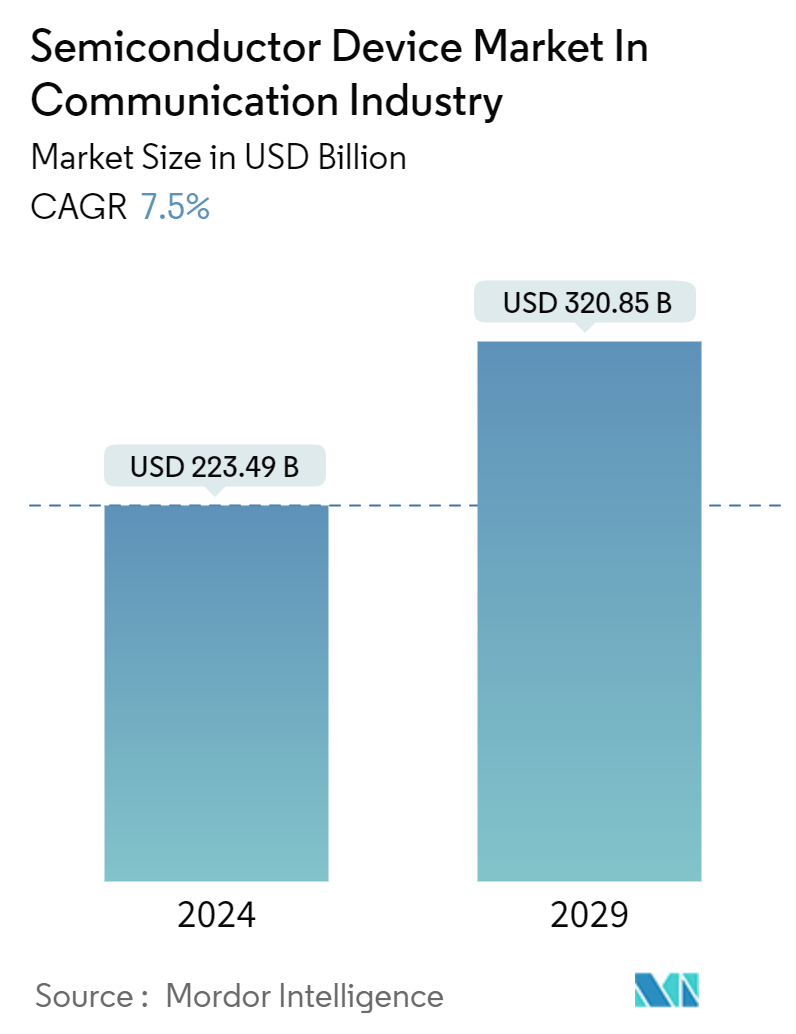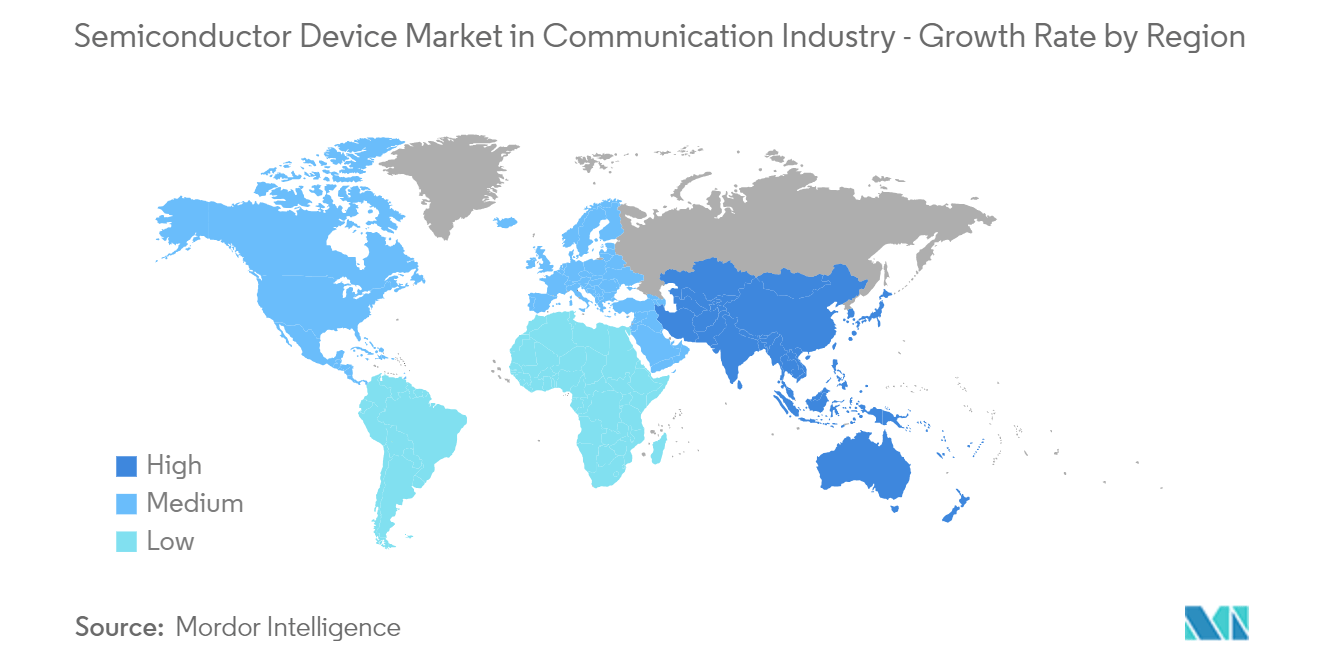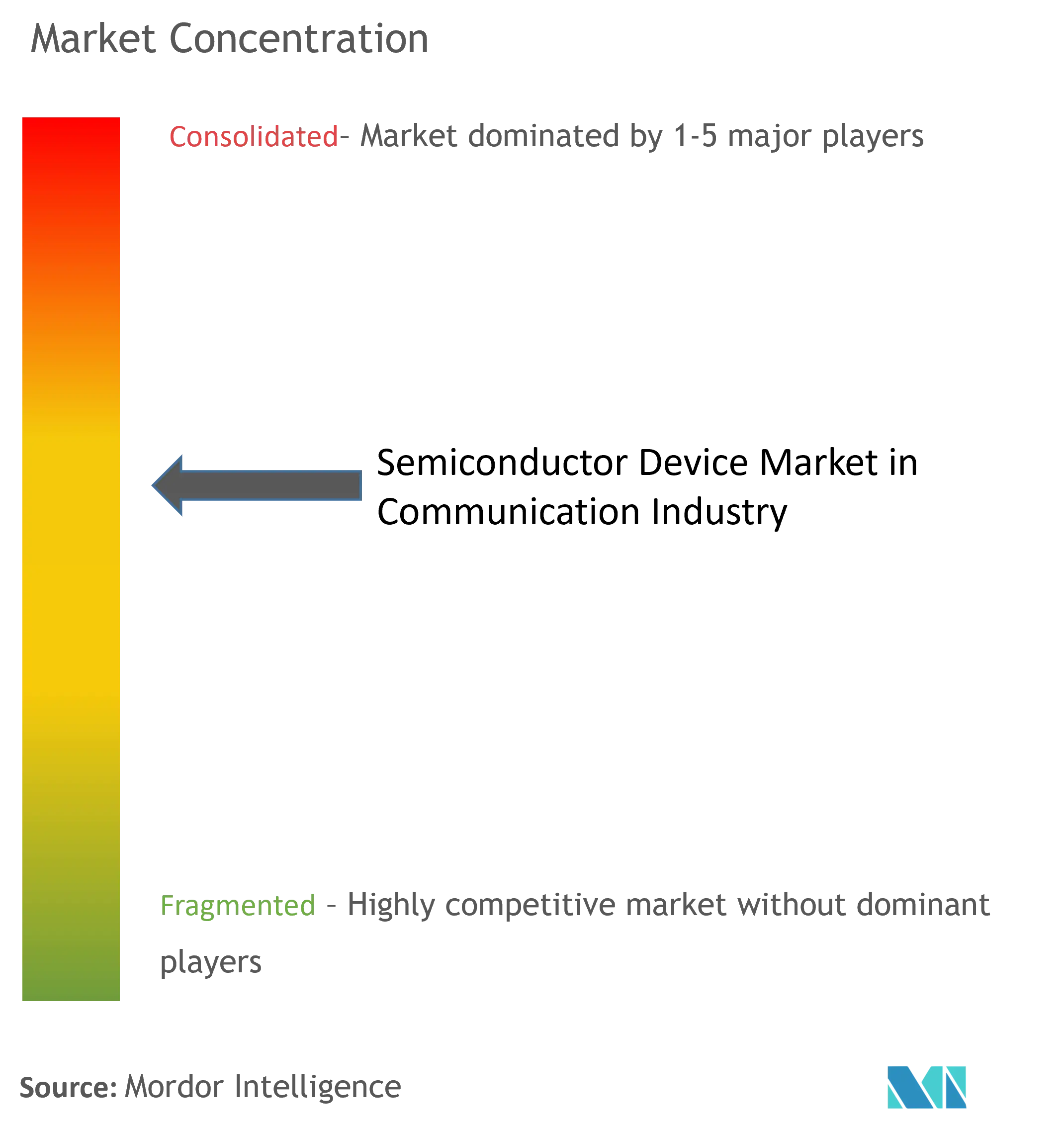Semiconductor Device Market Size

| Study Period | 2019 - 2029 |
| Market Size (2024) | USD 223.49 Billion |
| Market Size (2029) | USD 320.85 Billion |
| CAGR (2024 - 2029) | 7.50 % |
| Fastest Growing Market | Asia Pacific |
| Largest Market | Asia Pacific |
Major Players*Disclaimer: Major Players sorted in no particular order |
Semiconductor Device Market Analysis
The Semiconductor Device Market In Communication Industry is expected to grow from USD 223.49 billion in 2024 to USD 320.85 billion by 2029, at a CAGR of 7.5% during the forecast period (2024-2029).
The semiconductor device market in the communication industry is valued at USD 207.9 billion in the current year and is expected to register a CAGR of 7.5% during the forecast period to become USD 299.5 billion by the next five years.
- Wired or wireless semiconductors form an important part of communications technology, from network connectivity, base stations, and routers to phones, laptops, and other connected devices.
- In recent years, wireless technology has revolutionized the communication industry, with mobile subscriptions across the world growing at a rapid rate. The most familiar wireless application is the mobile phone, where smartphones account for a major share of all mobile subscriptions globally. Today's cell phones mostly use 4G wireless communications systems. The data transmission standards for 4G are extremely fast, and 5G systems currently in development will be even faster.
- The regional governments are taking initiatives to support the global rollout of 5G and are driving the growth of the semiconductor device market in the communication industry. For instance, the European Commission has established a public-private partnership to develop 5G technology. As a result, the European Commission has announced over GBP 700 million (~USD 889.5 million) in public funding to support the rollout of 5G across Europe through its Horizon 2020 program.
- Furthermore, investments in supporting IT infrastructure have also been growing to support the growing penetration of digital technologies and a growing number of internet users. For instance, by 2025, about 45 new data centers will come up in India, attracting investment of nearly USD 10 billion since 2020. Such trends generate a favorable outlook for the studied market's growth during the projected timeline.
- However, as miniaturization is one of the high-priority trends in the semiconductor industry, the increasing demand for smaller chips is expected to hinder the market's growth, as shrinking chip size significantly increases design and manufacturing complexity.
- Moreover, the pandemic increased the 5G deployment, digital transformation, and demand for high-speed network connectivity due to the remote work culture. The communication industry has been greatly impacted because communications are crucial to the efficient running of various industries, including the medical, governmental, and private sectors.
Semiconductor Device Market Trends
Growing Adoption of 5G Technology
- The increasing implementation of 5G has resulted in a significant demand for 5G-enabled devices like smartphones, which, in turn, drives the demand for the semiconductor device market in the communication industry.
- Ericsson forecasts that there will be 4.4 billion 5G subscriptions across the globe by the end of 2027, accounting for 48% of all mobile subscriptions. As per the company, 5G subscription uptake is faster than that of 4G following its launch in 2009, reaching 1 billion subscriptions two years earlier than 4G did.
- Key factors include the timely availability of devices from several vendors, with prices falling faster than 4G, and China's large, early 5G deployments. According to Ericsson, 5G will become the dominant mobile access technology by subscriptions in 2027.
- The improved 5G network and unlimited data plans will attract more 5G subscribers across the globe. Video-based apps, virtual/augmented reality, and gaming generate huge data traffic. According to GSMA, 5G subscriptions in North America will be more than 90%, the highest among all regions.
- Moreover, the deployment of 5G networks is increasing the demand for data centers. This is because 5G networks require a significant amount of data processing and storage capabilities to provide high-speed, low-latency connections to end users.
- Furthermore, in February 2023, GSMA reported that 5G connections are anticipated to double over the upcoming two years. In addition, GSMA also reported that the growth would come from key markets within APAC and LATAM, like Brazil and India, which have recently launched 5G networks. India will be particularly significant, with the expansion of services from Jio and Airtel in 2023 expected to be key to continued adoption in the region. Moreover, as per GSMA, 5G is anticipated to account for 145 million in India by the end of 2025.

Asia-Pacific to Hold Significant Market Share
- The emergence of different technologies, including the introduction of smartphones, tablets, and a variety of cloud-based services, has driven a steady increase in demand for faster and more pervasive personal mobile communication systems. This, in turn, has resulted in the introduction of a growing variety of wireless base stations (BTS), creating the connection points between the mobile terminals and the main wired network.
- The rapid growth of the IT sector and industrialization are also driving the demand for the semiconductor device market in the communications industry in the Asia-Pacific region. These sectors will greatly facilitate foreign investment, increasing the region's exposure to developed countries and new technologies. The private and public sectors are continuously investing heavily in developing the region's telecommunications industry, as the availability of high-speed and efficient telecommunications networks is essential for the growth of these sectors.
- The Japanese telecommunications industry is among the largest in the world in terms of revenue. Few major fixed and mobile network operators have invested heavily in towers and IT infrastructure over the past two decades despite the overall market being fueled by slow economic and demographic growth. 5G adoption is also gaining traction in the country, and Japan aims to reach almost full 5G coverage by the end of 2030.
- Moreover, the Indian communication industry has been witnessing sharp growth driven by a growing subscriber base and the liberal and reformist government approach towards the industry. For instance, according to IBEF, India is among the world's second-largest telecommunications markets, with a subscriber base of 1.16 billion until April 2022. Furthermore, in April-June 2022, the total number of internet subscribers in India reached 836.86 million. Additionally, the wireless segment accounted for 95.4% of the total telephone subscriptions In June 2022.
- Additionally, the Indian government has started to focus significantly on developing a solid digitized economy and is taking several initiatives to promote the adoption of digital technologies; this, in turn, is aiding the growth of the semiconductor device market in the communication industry in the region.
- Increasing the number of data centers may also offer massive opportunities for companies operating in the semiconductor device market in the communication industry. For instance, in March 2023, OVH Cloud announced the launch of its first data center in India as a part of its Asia Pacific expansion plan. The company will also deploy two additional data centers in Australia and Singapore by next year. Similarly, in June 2022, ST Telemedia Global Data Centers (STT GDC) announced its plans for a new data center site in South Korea.

Semiconductor Device Industry Overview
The semiconductor device market in the Communication Industry is experiencing fluctuations due to factors such as increased consolidation, rapid technological advancements, and shifting geopolitical dynamics. In a market where sustainable competitive advantages are driven by innovation, competition is on the rise. In this context, the importance of brand identity must be addressed, given the high-quality expectations of end-users when it comes to semiconductor manufacturing.
Several major players dominate this market, including Intel Corporation, Nvidia Corporation, Kyocera Corporation, Qualcomm Technologies Inc., and STMicroelectronics NV, leading to high levels of market penetration.
In April 2023, Kyocera Corporation announced a groundbreaking development - a new capacitor (MLCC) in the EIA 0201 size category, boasting the industry's highest capacitance at 10 microfarads. The KGM03 series from Kyocera is widely used in wearable devices and smartphones. The increased capacity of these compact MLCCs empowers designers to meet system requirements with fewer components and minimal space utilization.
In June 2022, Texas Instruments extended its connectivity portfolio by introducing new wireless microcontrollers (MCUs) that offer high-quality Bluetooth Low Energy (LE) at a fraction of the cost of competitors. The SimpleLink Bluetooth LE CC2340 series leverages the company's extensive experience in wireless communication and delivers best-in-class standby current and radio-frequency (RF) performance.
March 2022 saw Analog Devices Inc. introduce a millimeter-wave (mmW) 5G front-end chipset designed to cover the necessary frequency bands. This innovation enables designers to simplify their designs and bring smaller and more versatile 5G radios to the market faster. The chipset consists of four highly integrated ICs, offering a comprehensive solution that significantly reduces the number of components required for 24 to 47GHz 5G radios.
Semiconductor Device Market Leaders
-
Intel Corporation
-
Nvidia Corporation
-
Kyocera Corporation
-
Qualcomm Incorporated
-
STMicroelectronics NV
*Disclaimer: Major Players sorted in no particular order

Semiconductor Device Market News
- June 2022: Micron Technology Inc. launched the world's inaugural 176-layer NAND SATA SSD, tailored specifically for data center workloads. The Micron 5400 SATA SSD stands as a pinnacle of innovation in the realm of data center SATA SSDs. Leveraging the power of the 11th-generation SATA architecture, this SSD offers a wide range of applications, delivers significantly enhanced performance, and prolongs the lifespan of SATA platforms.
- January 2022: Toshiba Electronic Devices and Storage Corporation revealed its latest development in January 2022, introducing the TC9563XBG Ethernet bridge IC, designed to facilitate 10 Gbps communications in automotive information systems and industrial equipment. This marks a significant milestone for Toshiba, as it represents their first foray into the world of 2-port 10Gbps Ethernet interfaces integrated into a bridge IC. Users can select their preferred interface from a choice of USXGMII, XFI, SGMII, and RGMII. These dual ports are equipped to support Ethernet AVB and TSN, enabling real-time and synchronous data processing.
Semiconductor Device Market In Communication Industry Market Report - Table of Contents
1. INTRODUCTION
- 1.1 Study Assumptions and Market Definition
- 1.2 Scope of the Study
2. RESEARCH METHODOLOGY
3. EXECUTIVE SUMMARY
4. MARKET INSIGHTS
- 4.1 Market Overview
- 4.2 Industry Value Chain Analysis
-
4.3 Industry Attractiveness - Porter's Five Forces Analysis
- 4.3.1 Bargaining Power of Suppliers
- 4.3.2 Bargaining Power of Consumers
- 4.3.3 Threat of New Entrants
- 4.3.4 Threat of Substitute Products
- 4.3.5 Intensity of Competitive Rivalry
- 4.4 Impact of Macro Trends on the Industry
5. MARKET DYNAMICS
-
5.1 Market Drivers
- 5.1.1 Increasing Adoption of 5G Technology
-
5.2 Market Challenges
- 5.2.1 Semiconductor Chip Shortage
6. MARKET SEGMENTATION
-
6.1 By Device Type
- 6.1.1 Discrete Semiconductors
- 6.1.2 Optoelectronics
- 6.1.3 Sensors
- 6.1.4 Integrated Circuits
- 6.1.4.1 Analog
- 6.1.4.2 Logic
- 6.1.4.3 Memory
- 6.1.4.4 Micro
- 6.1.4.4.1 Microprocessors (MPU)
- 6.1.4.4.2 Microcontrollers (MCU)
- 6.1.4.4.3 Digital Signal Processor
-
6.2 By Geography
- 6.2.1 United States
- 6.2.2 Europe
- 6.2.3 Japan
- 6.2.4 China
- 6.2.5 Korea
- 6.2.6 Taiwan
7. COMPETITIVE LANDSCAPE
-
7.1 Company Profiles
- 7.1.1 Intel Corporation
- 7.1.2 Nvidia Corporation
- 7.1.3 Kyocera Corporation
- 7.1.4 Qualcomm Incorporated
- 7.1.5 STMicroelectronics
- 7.1.6 Micron Technology Inc.
- 7.1.7 Xilinx Inc.
- 7.1.8 NXP Semiconductors NV
- 7.1.9 Toshiba Corporation
- 7.1.10 Texas Instruments Inc.
- 7.1.11 Taiwan Semiconductor Manufacturing Company (TSMC) Limited
- 7.1.12 SK Hynix Inc.
- 7.1.13 Samsung electronics co. ltd
- 7.1.14 Fujitsu Semiconductor Ltd
- 7.1.15 Rohm Co. Ltd
- 7.1.16 Infineon Technologies AG
- 7.1.17 Renesas Electronics Corporation
- 7.1.18 Advanced Semiconductor Engineering Inc.
- 7.1.19 Broadcom Inc.
- 7.1.20 ON Semiconductor Corporation
- *List Not Exhaustive
8. INVESTMENT ANALYSIS
9. FUTURE OF THE MARKET
** Subject To AvailablitySemiconductor Device Industry Segmentation
A semiconductor device is an electronic component made from semiconductor materials like silicon. It exhibits variable electrical conductivity, enabling control and manipulation of electrical currents. Common semiconductor devices include transistors, diodes, and integrated circuits. These devices are fundamental in modern electronics, serving functions like signal amplification, switching, and signal processing. They form the core of microchips, enabling the operation of computers, smartphones, and countless other electronic devices, making them integral to the functioning of our technologically driven world.
The semiconductor device market in the consumer industry is divided into various segments, including discrete semiconductors, optoelectronics, sensors, and integrated circuits (analog, logic, memory, and micro (microprocessors, microcontrollers, and digital signal processors)). This market analysis encompasses regions such as the United States, Europe, Japan, China, Korea, Taiwan, and the Rest of the World.
Market sizes and future predictions are expressed in terms of monetary value (USD) for each of these segments.
| By Device Type | Discrete Semiconductors | ||
| Optoelectronics | |||
| Sensors | |||
| Integrated Circuits | Analog | ||
| Logic | |||
| Memory | |||
| Micro | Microprocessors (MPU) | ||
| Microcontrollers (MCU) | |||
| Digital Signal Processor | |||
| By Geography | United States | ||
| Europe | |||
| Japan | |||
| China | |||
| Korea | |||
| Taiwan |
Semiconductor Device Market In Communication Industry Market Research Faqs
How big is the Semiconductor Device Market In Communication Industry?
The Semiconductor Device Market In Communication Industry size is expected to reach USD 223.49 billion in 2024 and grow at a CAGR of 7.5% to reach USD 320.85 billion by 2029.
What is the current Semiconductor Device Market In Communication Industry size?
In 2024, the Semiconductor Device Market In Communication Industry size is expected to reach USD 223.49 billion.
Who are the key players in Semiconductor Device Market In Communication Industry?
Intel Corporation, Nvidia Corporation, Kyocera Corporation, Qualcomm Incorporated and STMicroelectronics NV are the major companies operating in the Semiconductor Device Market In Communication Industry.
Which is the fastest growing region in Semiconductor Device Market In Communication Industry?
Asia Pacific is estimated to grow at the highest CAGR over the forecast period (2024-2029).
Which region has the biggest share in Semiconductor Device Market In Communication Industry?
In 2024, the Asia Pacific accounts for the largest market share in Semiconductor Device Market In Communication Industry.
What years does this Semiconductor Device Market In Communication Industry cover, and what was the market size in 2023?
In 2023, the Semiconductor Device Market In Communication Industry size was estimated at USD 206.73 billion. The report covers the Semiconductor Device Market In Communication Industry historical market size for years: 2019, 2020, 2021, 2022 and 2023. The report also forecasts the Semiconductor Device Market In Communication Industry size for years: 2024, 2025, 2026, 2027, 2028 and 2029.
Semiconductor Device Market In Communication Industry Industry Report
Statistics for the 2024 Semiconductor Device In Communication Industry market share, size and revenue growth rate, created by Mordor Intelligence™ Industry Reports. Semiconductor Device In Communication Industry analysis includes a market forecast outlook to for 2024 to 2029 and historical overview. Get a sample of this industry analysis as a free report PDF download.




